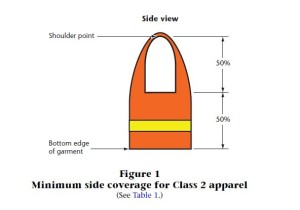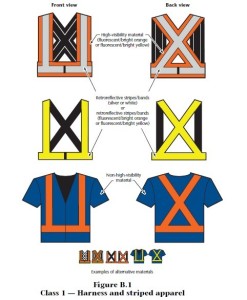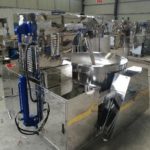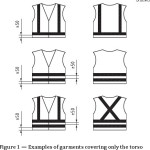marytest可为您提供加拿大市场的反光服 (HVSA) CSA Z96标准及ANSI/ISEA标准测试和CSA认证服务。
marytest为您提供以下反光服产品提供本地化CSA测试与认证服务:反光服、反光条纹或反光带
反光服套于身体最外层,可以是衣裤相连的工作服或背心,而反光条纹或反光带可视为独立的物品或反光服装一部分,在施工、紧急救护、休闲体育和其它环境中使用。
CSA 测试与认证可帮助确保 HVSA 的性能满足 CSA Z96 的要求,包括颜色、反光性、最小覆盖面积、材料配置(设计)和所使用背景材料的物理特性。 在测试中,HVSA 产品会经受各种测试条件和环境,包括磨损、弯曲、低/高温、潮湿、洗涤和干洗。
标准解决方案
CSA 拥有开发相关的 HVSA 标准的经验。 CSA Z96 已被加拿大省级和地方法规所引用,管理各种场合下可突出用户的职业服装。 CSA Z96.1 是我们开发的指导性文件,与 CSA Z96 配套使用,它针对了与 HVSA 挑选、护理和使用相关的最佳实践及在工作场所实施 HVSA 方案所需的组件。
反光服CSA测试认证相关标准:
CSA Z96-02 Class 2 High-Visibility Safety Apparel
CSA Z96.1-08 – Guideline on Selection, Use, and Care of High-Visibility Safety Apparel
CSA Z96-09 (R2014) – High-visibility safety apparel反光服CSA2014新标准
AS/NZS 1906.4:2010 retroreflective materials and devices for road traffic control purposes-high-visibility materials for safety garments
ANSI/ISEA 107-2010 American National Standard for High-Visibility Safety Apparel and Headwear
反光服CSA Z96-09(R2014)部分内容展示:
反光服测试相关项目如下:
布料检测、 荧光材料检测 、面料色牢度检测、反光条检测
设计要素
荧光材料的荧光度检测
原样荧光度
经过氙灯照射过的荧光度测试
摩擦色牢度
汗液色牢度
皂洗色牢度
干洗色牢度
氯漂色牢度
热压色牢度
拉伸断裂强度(机织物)
胀破强力(针织物)
撕裂强度
透湿性
反光条的反光度检测
原样反光度
摩擦后
挠曲后
低温折叠后
经过温差后
皂洗后
干洗后
雨淋后
CSA Z96标准相关介绍
一、 CSA Z96.1-08
CSA Z96.1-08- Guideline on Selection, Use, and Care of High-Visibility Safety Apparel
CSA Z96.1-08- Guideline on Selection, Use, and Care of High-Visibility Safety Apparel
Preface
This is the first edition of CSA Z96.1, Guideline on selection, use, and care of high-visibility safety apparel. It is to be used in conjunction with CAN/CSA-Z96, High-visibility safety apparel.
1. Scope
1.1 This Guideline specifies best practices for the proper selection, use, and care of high-visibility safety apparel.
1.2 This Guideline outlines the essential components necessary for the implementation of an effective high-visibility safety apparel program in the workplace.
1.3 This CSA Guideline contains advice for the users of high-visibility safety apparel, indicated by the word “should”. It does not impose any requirements separate from those specified in CAN/CSA-Z96, although it indicates where such requirements apply to high-visibility safety apparel by the words “is required”. The word “may” is used to express an option or that which is permissible within the limits of the Guideline. Notes accompanying clauses do not include requirements or alternative requirements; the purpose of a note accompanying a clause is to separate from the text explanatory or informative material.
1.4 The values given in SI (metric) units are the standard. The values given in parentheses are for information only.
二、Z96-09 (R2014)
Z96-09 (R2014) – High-visibility safety apparel
Preface
This is the second edition of CSA Z96, High-visibilit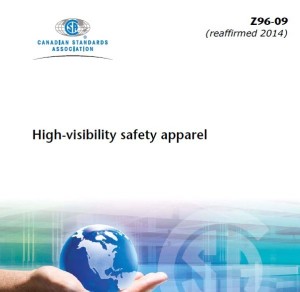 y safety apparel. It supersedes the previous edition published in 2002, and is based on the identically titled American National Standards Institute Standard ANSI/ISEA 107. It is also designed to be in harmony with CEN EN 471.
y safety apparel. It supersedes the previous edition published in 2002, and is based on the identically titled American National Standards Institute Standard ANSI/ISEA 107. It is also designed to be in harmony with CEN EN 471.
 y safety apparel. It supersedes the previous edition published in 2002, and is based on the identically titled American National Standards Institute Standard ANSI/ISEA 107. It is also designed to be in harmony with CEN EN 471.
y safety apparel. It supersedes the previous edition published in 2002, and is based on the identically titled American National Standards Institute Standard ANSI/ISEA 107. It is also designed to be in harmony with CEN EN 471.Scope
1.1 This Standard specifies requirements for occupational apparel that is (a) capable of signalling the user’s presence visually; and (b) intended to provide the user with conspicuity in hazardous situations under any light conditions and under illumination by vehicle headlights.
1.2 Performance requirements are included for colour, retroreflection, and minimum areas, as well as for the configuration of the materials. Performance requirements are also provided for the physical properties of background materials used in the construction of high-visibility safety apparel (referred to as “HVSA” in this Standard). Test methods are provided in the Standard to ensure that a minimum level of visibility is maintained when garments are subjected to ongoing care procedures.
1.3 This Standard provides performance requirements for conspicuous materials to be used in HVSA and specifies classes of garments, minimum areas, and placement of these materials. Note: Conspicuity is enhanced by high contrast between clothing and the work environment against which it is seen.
1.4 This Standard specifies minimum amounts of retroreflective materials, together with colour and requirements for placement of materials, for apparel used to enhance the visibility and safety of workers. Categories of high-visibility garments are identified and appropriate markings for apparel are recommended.
1.5 In CSA Standards, “shall” is used to express a requirement, i.e., a provision that the user is obliged to satisfy in order to comply with the standard; “should” is used to express a recommendation or that which is advised but not required; “may” is used to express an option or that which is permissible within the limits of the standard; and “can” is used to express possibility or capability. Notes accompanying clauses do not include requirements or alternative requirements; the purpose of a note accompanying a clause is to separate from the text explanatory or informative material. Notes to tables and figures are considered part of the table or figure and may be written as requirements. Annexes are designated normative (mandatory) or informative (non-mandatory) to define their application.

